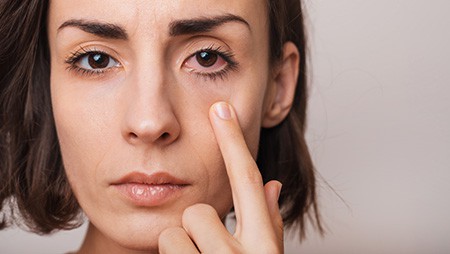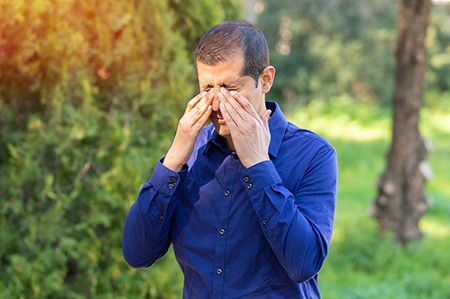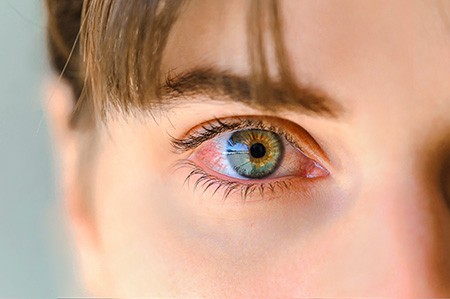
Dry or red eyes and ocular allergies are some of the most prevalent eye conditions. These eye problems can be confused with each other, making it challenging for patients to find long-term relief. Exposure to allergens and dry eye disease have overlapping symptoms, and many people have both conditions that feed each other, causing severe symptoms. Treatment for dry eyes, red eyes, and ocular allergies can be complicated, especially for misdiagnosed patients.
Our experienced ophthalmologists offer comprehensive eye exams and know how to identify these similar eye conditions. Laser Eye Center™ is at the forefront of eye care and surgery, offering new treatments with the latest technology. With more than 30 years of successful procedures, our eye doctors are the best of the best and have trained other renowned ophthalmologists in the region.
What Causes Red Eyes?
Red eyes are a symptom of dozens of eye conditions or injuries that cause irritation, swelling of blood vessels, or blood in the eye. Dry eyes and eye allergies can cause red eyes, but so can angle-closure glaucoma, eye infection, lymphoma, ocular rosacea, uveitis, photokeratitis, and retinoblastoma. It’s best to schedule an eye exam when you first notice eye redness to determine what’s causing this symptom and if it’s part of a more significant health concern.
What Causes Dry Eyes?
There are two types of dry eyes: tear-deficient dry eye, caused by a lack of tears from the lacrimal gland, and evaporative dry eye disease (EDED), which happens when there’s an issue with the layers of the tear film. Tears keep the cornea (front surface of the eye) lubricated for clear vision, and a healthy tear film is balanced with three layers: oil (lipids or meibum), water (aqueous), and mucous (mucin).
EDED is the most common dry eye disease (85%), and meibomian gland dysfunction (MGD) is responsible for most EDED cases. Meibomian glands in the upper and lower eyelids secrete lipids that stabilize the tear film and coat aqueous tears to prevent evaporation. MGD develops when these glands are clogged or blocked, causing dry, red eyes and other painful symptoms.
Natural aging tends to cause dry eyes, and women are more likely to develop dry eyes, especially during hormonal shifts like menopause. Living in a desert climate with low humidity and exposure to allergens, smoke, wind, chemicals, and dust can cause or worsen dry eye disease. Excessive screen time is another culprit because you blink less often when watching TV or working on a computer.
Certain health conditions, contact lenses, previous refractive surgery, and some medications can cause dry eyes.
What Are Ocular Allergies?

The medical term for ocular allergies is allergic conjunctivitis. When your eyes are exposed to an allergen, such as pet dander or pollen, mast cells in the eyes release histamine and other substances to fight off the allergen. That histamine release causes eye redness, swelling, and itching in the eyelids and conjunctiva (a thin mucous membrane that coats the inside of the eyelids and the front of the eye). The eyes may burn and tear up with ocular allergies.
Eye allergies can contribute to dry eye because they are often treated with antihistamines that decrease tear production. Chronic allergic conjunctivitis may cause tissue changes in the meibomian glands and disrupt the tear film. People with ocular allergies may also have nasal symptoms, such as an itchy or stuffy nose and sneezing.
People with eye allergies may react to:
- Pet dander
- Dust
- Pollen
- Smoke
- Mold
- Food
- Perfumes
- Cleaning products or chemicals
- Make-up and skincare products like eyeliner, mascara, eye shadow, concealer, and eye creams
Ocular allergy symptoms overlap with dry or red eyes. Our ophthalmologists can distinguish between the two and determine if you have dry eyes, eye allergies, or both.
Should You Use Over-the-Counter Eye Drops for Itchy, Red, or Dry Eyes?
Artificial tears sold over the counter can provide temporary relief by washing allergens out of the eye. These products can provide temporary relief for dry or red eyes by adding moisture. These eye drops don’t require a prescription and can be used up to six times a day or as often as necessary if they’re preservative-free.
Two types of over-the-counter eye drops can help with eye irritation:
- Artificial tears and eye drops that moisten the eye to supplement natural tears and improve lubrication.
- Eye drops that work to reduce or eliminate red eyes by constricting blood vessels in the eye.
Eye drops for redness can be an issue for some patients because they mask the symptoms of more severe conditions, which may lead to misdiagnosis.
All in all, over-the-counter eye drops can be helpful for short-term relief, but a combination approach works best. Our ophthalmologists at Laser Eye Center™ treat the source of your dry eyes, red eyes, or eye allergies. That may involve avoiding or reducing exposure to allergens, prescription eye drops containing steroids or antihistamines, improving meibomian gland function, or treatment with iLux or BlephEx technologies.
What’s the Difference Between Red, Dry Eyes and Eye Allergies?

The main difference between eye allergies and dry eye disease is intense itching caused by allergen exposures. Dry eyes may cause itching but not as fierce as an allergic reaction. Eye itching with a runny nose or watery eyes is typically allergic conjunctivitis. Dry eyes often cause stinging and burning, which may not happen with eye allergies. However, both conditions can cause these symptoms:
- Red eyes
- Watery eyes
- Light sensitivity
- Blurry vision
- Mucous discharge
You likely have eye allergies if you feel the urge to rub your eyes or have eyelid puffiness or swelling. On the other hand, if you have scratchy sensations or feel like something is in your eye, you may have dry eye disease.
Dry Eyes Can Lead to Eye Allergies, and Eye Allergies Can Lead to Dry Eyes
Seasonal allergies to pollen and airborne particles cause inflammation that triggers dry eyes. A healthy tear film lubricates the eye and protects against allergens, but people with existing dry eyes don’t have that and are more likely to develop allergic conjunctivitis. Dry eye symptoms tend to peak in the Spring when pollen counts are highest, according to an evaluation of nearly 607,000 veterans treated for dry eye at Veterans Affairs clinics.
Do You Have Dry Eyes or Eye Allergies?
Schedule a comprehensive eye exam at Laser Eye Center™ to get to the bottom of your symptoms. Contact our SoCal offices at (800) 649-2659 to book your appointment with an experienced ophthalmologist.
SOURCES:
- https://www.aao.org/eye-health/diseases/allergies
- https://www.aao.org/eye-health/news/allergies-linked-to-dry-eye
- https://dmei.org/blog/how-to-tell-the-difference-between-dry-eye-and-allergies/
- https://www.urmc.rochester.edu/encyclopedia/content.aspx?contenttypeid=1&contentid=3069
- https://www.aao.org/eye-health/symptoms/red-eye-3
- https://www.bheyeguy.com/services/dry-eyes-red-eyes-allergies
- https://www.ncbi.nlm.nih.gov/pmc/articles/PMC6202299/
Schedule your free consult today
Click here to learn moreGet started on your journey to clearer, crisper vision with Laser Eye Center™. Our expert team of doctors are trained and skilled in the latest technology and methods for laser vision correction. To learn more about our state-of-the-art All Laser LASIK technology or about All Laser LASIK itself, contact us today. Schedule your FREE All Laser LASIK consultation by calling today.

